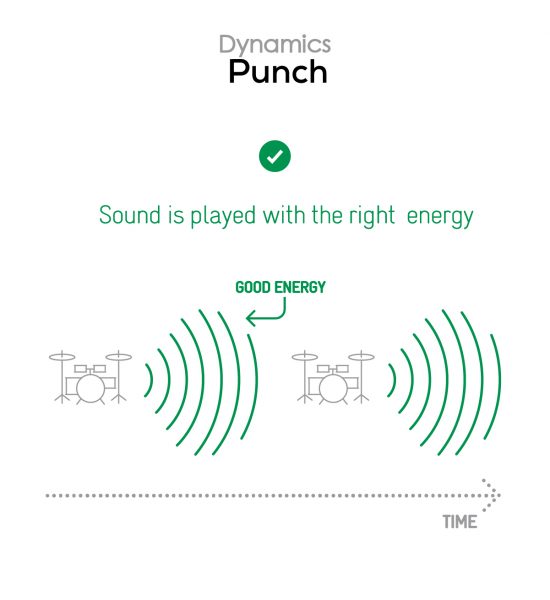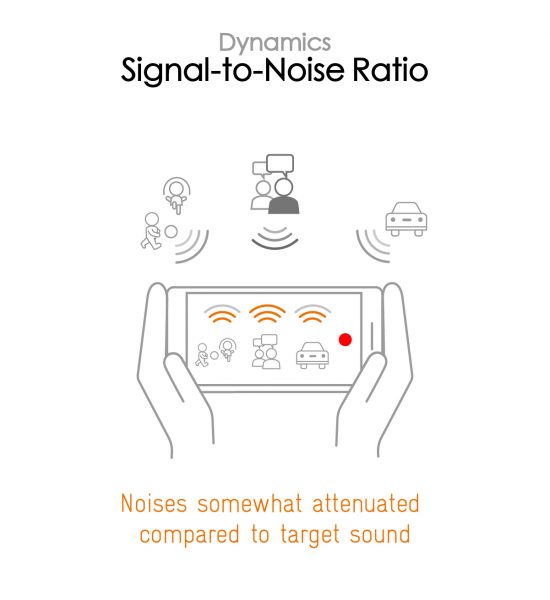We put the Google Pixel 6 Pro through our rigorous DXOMARK Audio test suite to measure its performance both at recording sound using its built-in microphones, and at playing audio back through its speakers.
In this review, we will break down how it fared in a variety of tests and several common use cases.
Overview
Key audio specifications include:
- Two speakers (one bottom right, side-firing, and one top, front-firing)
- Three microphones
- Audio zoom
- USB Type-C input for headphones (no 3.5mm jack)
Scoring
Sub-scores and attributes included in the calculations of the global score.
Google Pixel 6 Pro


 19th
19th
 11th
11th
Playback
Pros
- Deeper low-end extension and stronger low midrange than Pixel 6, which also helps the sensation of punch
- Tonal Balance remains fairly identical at soft volumes
- Natural position of hands doesn’t block any speaker
Cons
- The center is shifted towards the right when listening to music.
- Dynamics are impaired by heavy compression at maximum volume.
- Stereo doesn’t follow the phone’s rotation when listening to music (only when watching movies).
- Numerous artifacts detected
Recording
Pros
- Good tonal balance across all use cases
- Relatively free from artifacts, even when recording in loud environments
- Loudness in recordings is very good, all the while remaining clean.
Cons
- Limited wideness and poorer localizability in life videos
- Inferior spatial results in selfie videos
The Google Pixel 6 Pro bests its predecessors and delivers a very good performance when compared to all the phones in our Audio rankings.
Google’s 2021 flagship fares reasonably well across all use cases. In the recording area, the Google Pixel 6 Pro gets notably better and turns in above-average results, with a harmonious tonal balance, accurate dynamic attributes, and skills in high-SPL scenarios, making it a good choice for recording concerts, filming selfie videos, and sending memos.
Test summary
About DXOMARK Audio tests: For scoring and analysis in our smartphone audio reviews, DXOMARK engineers perform a variety of objective tests and undertake more than 20 hours of perceptual evaluation under controlled lab conditions.
(For more details about our Playback protocol, click here; for more details about our Recording protocol, click here.)
The following section gathers key elements of our exhaustive tests and analyses performed in DXOMARK laboratories. Detailed performance evaluations under the form of reports are available upon request. Do not hesitate to contact us.
Playback
Google Pixel 6 Pro
163
DXOMARK engineers test playback through the smartphone speakers, whose performance is evaluated in our labs and in real-life conditions, using default apps and settings.
In playback, the Google Pixel 6 Pro is rather well suited for gaming thanks to very good spatial attributes (localizability, wideness and distance rendering), natural midrange, correct volume results, and speakers that are fairly hard to occlude by the user’s hands. As for drawbacks, the phone turns in poor spatial results when playing music or watching a movie, and suffers from an aggressive compression, especially problematic at loud volumes. It also delivers a midrange-focused frequency response lacking both high- and low-end, which nonetheless remains more pleasant than the standard Google Pixel 6’s.
Listen to the tested smartphone’s playback performance in this comparison with some of its competitors:
Here is how the Google Pixel 6 Pro performs in playback use cases compared to its competitors:

Timbre
Google Pixel 6 Pro
158
The Timbre score represents how well a phone reproduces sound across the audible tonal range and takes into account bass, midrange, treble, tonal balance, and volume dependency. It is the most important attribute for playback.
The Google Pixel 6 Pro does an average job of accurately reproducing tones, including fairly smooth midrange along with clear and precise high-end. Sibilances can be heard, but sound less aggressive compared to the standard Pixel 6.
Overall, the tonal balance is a bit thin and midrange-focused, and slightly muffled when playing bass-heavy content. While low-end extension isn’t as deep and low midrange isn’t as present as one would hope, they are still better than with the 6. Additionally, low-frequency information manages to remain audible thanks to deliberately added harmonics. If you wish to know more about this technique, you can check out our article about the evolution of smartphone audio.
At low volumes, the Pixel 6 Pro’s tonal balance remains fairly consistent, whereas it significantly varies at maximum volume due to excessive compression. In this case, the low-end information, otherwise perceptible, tends to completely disappear.

Dynamics
Google Pixel 6 Pro
149
The Dynamics score measures the accuracy of changes in the energy level of sound sources, for example how precisely a bass note is reproduced or the impact sound from drums.
All dynamic attributes highly depend on volume. At soft and nominal volumes, attack is only slightly dulled, bass is precise, and punch is relatively impactful. However, at loud volumes, attack and bass envelope get crushed by an aggressive compression, which entirely stifles all punchy efforts, except when watching movies.
These numerous temporal artifacts are particularly noticeable on rich, loud music. Lighter music genres (less compressed and less dense, harmonically speaking) are less affected by this ill-adapted compression.



Spatial
Google Pixel 6 Pro
162
The sub-attributes for spatial tests include pinpointing a specific sound's location, its positional balance, distance, and wideness.


Distance rendering is realistic (especially in movies, where voices are particularly upfront, therefore very intelligible), and localizability of the sound sources within the field is fairly precise. In terms of use cases, games fare best, and by far, thanks to very good localizability, balance, and wideness.

Volume
Google Pixel 6 Pro
162
The Volume score represents the overall loudness of a smartphone and how smoothly volume increases and decreases based on user input.
Here are a few sound pressure levels (SPL) measured when playing our sample recordings of hip-hop and classical music at maximum volume:
| Hip-Hop | Classical | |
| Google Pixel 6 Pro | 73 dBA | 69 dBA |
| Apple iPhone 13 Pro Max | 72.4 dBA | 69.5 dBA |
| Samsung Galaxy S22 Ultra (Exynos) | 74.1 dBA | 70.2 dBA |

Artifacts
Google Pixel 6 Pro
157
The Artifacts score measures the extent to which the sound is affected by various types of distortion. The higher the score, the less the disturbances in the sound are noticeable. Distortion can occur because of sound processing in the device and because of the quality of the speakers.


It represents the distortion and noise of the device playing our test signal (0 dB Fs, Sweep Sine in an anechoic box at 40 cm) at the device's maximum volume.
Recording
Google Pixel 6 Pro
157
DXOMARK engineers test recording by evaluating the recorded files on reference audio equipment. Those recordings are done in our labs and in real-life conditions, using default apps and settings.
In recording tests, the Pixel 6’s pro version held its own in loud environments: at high SPL, very good dynamics, a rather harmonious tonal balance, immersive spatial attributes in life videos (videos filmed in landscape mode with the rear cameras), and very few artifacts make it a decent choice for filming concerts. Selfie videos and memos are also quite satisfactory. However, the microphones are unable to properly handle shouting voices or wind.
Here is how the Google Pixel 6 pro performs in recording use cases compared to its competitors:

Timbre
Google Pixel 6 Pro
147
The Timbre score represents how well a phone captures sounds across the audible tonal range and takes into account bass, midrange, treble, and tonal balance. It is the most important attribute for recording.
When recording in loud environments, however, if the tonal balance remains relatively clean, high mids can become slightly too prominent.

Dynamics
Google Pixel 6 Pro
146
The Dynamics score measures the accuracy of changes in the energy level of sound sources, for example how precisely a voice's plosives (the p's, t's and k's, for example) are reproduced. The score also considers the Signal-to-Noise Ratio (SNR), for example how loud the main voice is compared to the background noise.



Spatial
Google Pixel 6 Pro
157
The sub-attributes for spatial tests include pinpointing a specific sound's location, its positional balance, distance, and wideness on the recorded audio files.



Volume
Google Pixel 6 Pro
170
The Volume score represents how loud audio is normalized on the recorded files and the how the device handles loud environments, such as electronic concerts, when recording.
Here are the sound levels recorded in the audio and video files, measured in LUFS (Loudness Unit Full Scale); as a reference, we expect loudness levels to be above -24 LUFS for recorded content:
| Meeting | Life Video | Selfie Video | Memo | |
| Google Pixel 6 Pro | -27.5 LUFS | -19.6 LUFS | -17.6 LUFS | -20 LUFS |
| Apple iPhone 13 Pro Max | -25.5 LUFS | -22.7 LUFS | -20.1 LUFS | -18.2 LUFS |
| Samsung Galaxy S22 Ultra (Exynos) | -28.8 LUFS | -21.7 LUFS | -21.2 LUFS | -23.9 LUFS |

Artifacts
Google Pixel 6 Pro
145
The Artifacts score measures the extent to which the recorded sounds are affected by various types of distortions. The higher the score, the less the disturbances in the sound are noticeable. Distortions can occur because of sound processing in the device and the quality of the microphones, as well as user handling, such as how the phone is held.


Compared to the competition, the Pixel 6 Pro is highly sensitive to wind noise. In this audio comparison, you can listen to the way this smartphone handles wind noise relative to its competitors:

Background
Google Pixel 6 Pro
166
Background evaluates how natural the various sounds around a voice blend into the video recording file. For example, when recording a speech at an event, the background should not interfere with the main voice, yet it should provide some context of the surroundings.



 English
English 中文
中文
DXOMARK invites our readership (you) to post comments on the articles on this website. Read more about our Comment Policy.